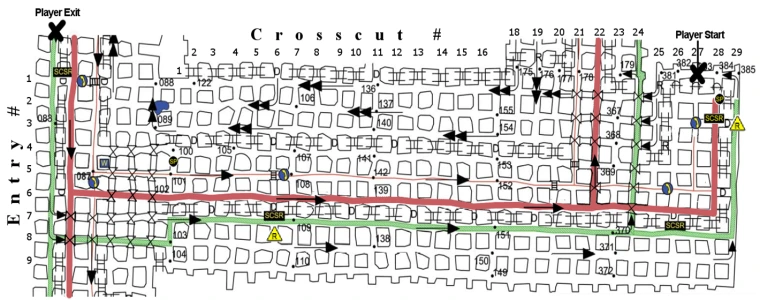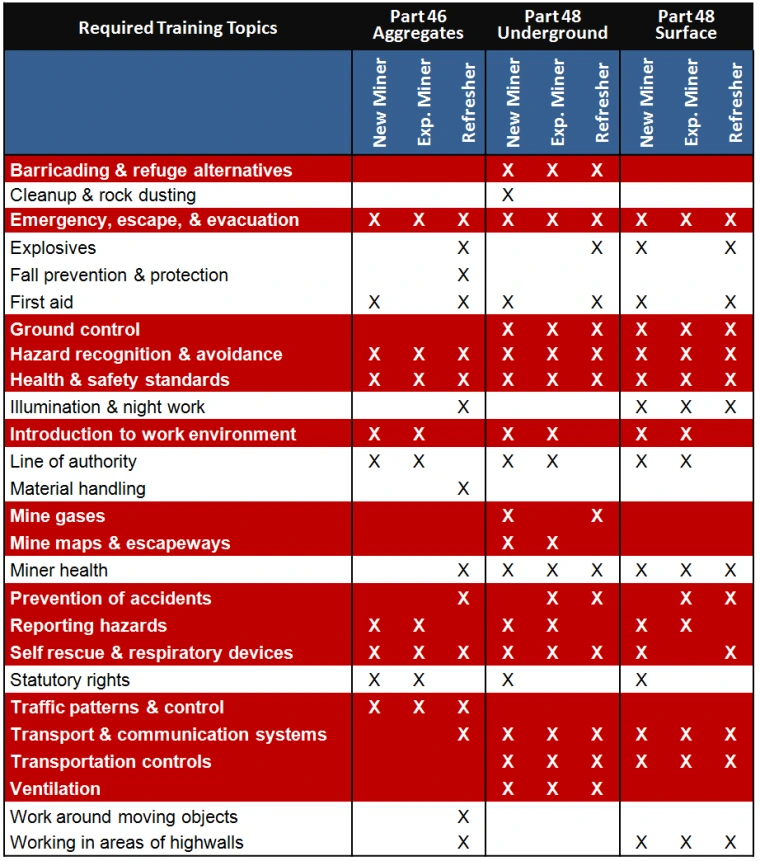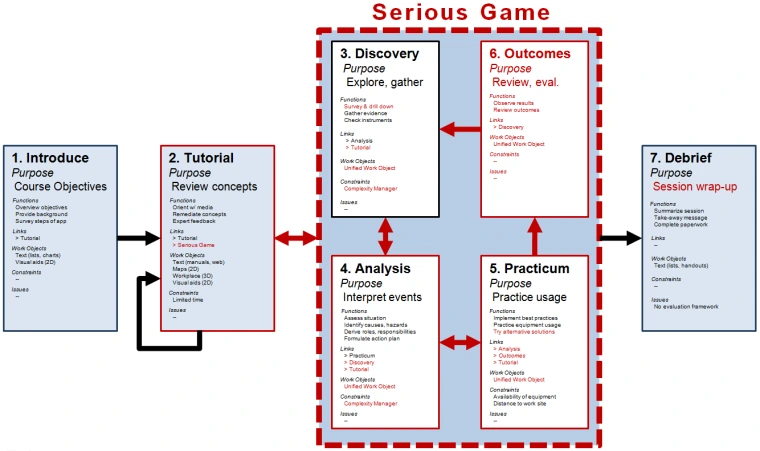
The Center's serious games initiative was born out a multi-year, comprehensive needs assessment, which identified several common deficiencies in training workflows for safety and health training in the mining industry.
Training Needs Assessment
Certain key features and capabilities must be present in training to facilitate the learning process.[1][2][3][4] For instance, Garris suggests a diverse set of attributes that include engaging visual context and themes, clear rules and goals, notable sensory stimuli, difficult challenges, appropriate levels of information complexity, and active learner control.[4] Wilson extends these attributes to include adaptation, assessment, conflict, interaction (equipment, interpersonal, social), language and communication, location, pieces and players, progress and surprise, representation, and safety.[5] While a diversity of training options and capabilities exist, it is not clear which attributes will yield the best results nor how to most effectively deliver them to support training in mining safety and health.
To gain a better understanding of training needs and practices, we conducted a series of field studies examining the instructional media and delivery methods used in mine safety training.[6] We applied an empirical technique called Contextual Inquiry and Design to characterize training from the perspective of information science, examining its construction, execution, and impact on the flow of information to achieve goals.[7] This novel perspective on training can yield major insights that would be difficult to obtain using more traditional research methods in pedagogy. Specifically our needs assessment sought to answer the following key questions:
- How are learning objectives aligned with information resources?
- How is information applied to achieve the learning objectives?
- Where is the information located, physically or electronically?
- What relationships and preconditions exist in the learning space?
- What relationships exist among pieces of information?
- What types of information are needed by learners at a given time?
To select representative training topics for deeper study, we consulted with the Lowell Institute for Mineral Resources' Safety & Health Technical Advisory Committee (TAC). Our field studies examined topics required for 30 CFR Parts 46/48 new miner and annual refresher courses, centering on the themes of introducing the workplace, avoiding accidents, recognizing hazards, and preparing for emergencies. These focal topics are highlighted in red in the required training topics matrix below.

Over a three year period, more than one thousand individual pieces of evidence were collected, including observations, comments, and inferences, as well as a large body of sample media such as slides, photos, videos, handouts, workbooks, and software. We noted that a substantial portion — but not all — of the training was lecture-based. Our field study data set provided a reasonably complete picture of the media and delivery methods used for MSHA certification training.
Evidence-Based Redesign
To make sense of this data set, a detailed analysis was performed and a study model developed to outline the structure and flow of training.[6] From this model we could then identify key deficiencies in the design of training resources and the workflows of training delivery. The diagram below depicts the essence of current safety training practices. The workflow is notably linear and focuses on introducing large amounts of content and vocabulary in a fixed period of time. Assessment centers on what can be learned quickly — not how knowledge is applied or what behaviors should be reinforced.

To address these problems, we proposed a dual solution: 1) Fifteen Design Guidelines for Mine Safety Training were derived, cross-validated, and pilot tested with 40 industry trainers. These guidelines make critical recommendations to improve the effectiveness of training materials for mining safety and health. 2) We then proposed a fundamental redesign of the training workflow around five major recommendations, which address the structural deficiencies observed in our study model:
- Improve access to training materials, spatially and conceptually.
- Coordinate and correlate important information, making relationships clear.
- Improve access to scaffolding, such as tutorials, to remediate step-wise deficiencies.
- Enable a non-linear process of information discovery, analysis, and practicum.
- Coupe learning with skills-based competency assessment.
The re-designed study model is outlined below, with our changes illustrated in red. Note that the new workflow is user-driven and substantially non-linear, incorporating a cycle of trial-and-error, consequences, and context-dependent remediation, as per the recommendations. Our analysis suggests that most of these features can be implemented using well-designed computer-based serious games, with the games forming the core of the training workflow. For a discussion of the usability challenges in mine safety training and their implications on serious games design, consult our Technical Report (PDF).[8]

- Juul, J. (2003) "The Game, the Player, the World: Looking for a Heart of Gameness," In Copier, M. & Raessens, J. (Eds.), Proc. Level Up: Digital Games Research Conference. Utrecht, Netherlands, pp. 30-45. ISBN: ISSN 2342-9666
- Malone, T.W. & Lepper, M.R. (1987). "Making Learning Fun: A Taxonomy of Intrinsic Motivations for Learning," In Snow, R.E., & Farr, M.J (Eds.), Aptitude, Learning and Instruction III: Conative and Affective Process Analyses Volume. Erlbaum: Hillsdale, NJ, pp. 223-253. ISBN: 978-0898597219
- Thiagarajan, S. (1999). "Team Activities for Learning and Performance," In Stolovitch, H.D. & Keeps, E.J. (Eds.), Handbook of Human Performance Technology. Jossey-Bass/Pfeiffer: San Francisco, pp. 518-544. ISBN: 978-0787965303
- Garris, R., Ahlers, R., & Driskell, J.E. (2002). "Games, Motivation, and Learning: A Research and Practice Model." Simulation and Gaming, 33(4), pp. 441-467. https://doi.org/10.1177/1046878102238607
- Wilson, K.A., Bedwell, W.L., Lazzara, E.H., Salas, E., Burke, C.S., Estock, J.L., Orvis, K.L., & Conkey, C. (2009). "Relationships Between Game Attributes and Learning Outcomes." Simulation and Gaming, 40 (2), pp. 217-266. https://doi.org/10.1177/1046878108321866
- Brown, L. D. (2015). Design, Evaluation, and Extension of Serious Games for Training in Mine Safety. Ph.D. Dissertation, Dept. of Computer Science, Univ. of Arizona, Tucson, AZ. Available at Univ. of Arizona Libraries
- Beyer, H. & Holtzblatt, K. (1997). Contextual Design: Defining Customer-Centered Systems. Morgan Kaufmann: San Francisco. ISBN: 1558604111.
- Brown, L.D. & Poulton, M. (2019). "Improving Safety Training through Gamification: An Analysis of Gaming Attributes and Design Prototypes," In Cassenti, D. (Ed.) Applied Human Factors and Ergonomics 2018. LNCS v. 780, Heidelberg: Springer, pp. 392-403. (NIOSH invited paper.) https://doi.org/10.1007/978-3-319-94223-0_37

